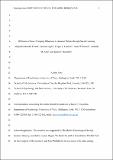Files in this item
Diffusion of novel foraging behaviour in Amazon parrots through social learning
Item metadata
| dc.contributor.author | Picard, Alejandra Morales | |
| dc.contributor.author | Hogan, Lauren | |
| dc.contributor.author | Lambert, Megan L. | |
| dc.contributor.author | Wilkinson, Anna | |
| dc.contributor.author | Seed, Amanda Madeleine | |
| dc.contributor.author | Slocombe, Katie | |
| dc.date.accessioned | 2017-10-26T23:31:54Z | |
| dc.date.available | 2017-10-26T23:31:54Z | |
| dc.date.issued | 2017-03 | |
| dc.identifier | 248157001 | |
| dc.identifier | fdb21624-b850-445a-8376-c02e5e1326db | |
| dc.identifier | 000394313400015 | |
| dc.identifier | 84992417323 | |
| dc.identifier | 000394313400015 | |
| dc.identifier.citation | Picard , A M , Hogan , L , Lambert , M L , Wilkinson , A , Seed , A M & Slocombe , K 2017 , ' Diffusion of novel foraging behaviour in Amazon parrots through social learning ' , Animal Cognition , vol. 20 , no. 2 , pp. 285-298 . https://doi.org/10.1007/s10071-016-1049-3 | en |
| dc.identifier.issn | 1435-9448 | |
| dc.identifier.other | ORCID: /0000-0002-3867-3003/work/60426877 | |
| dc.identifier.uri | https://hdl.handle.net/10023/11931 | |
| dc.description | This research was supported by The British Psychological Society Summer Bursary, awarded to Lauren Hogan. | en |
| dc.description.abstract | While social learning has been demonstrated in species across many taxa, the role it plays in everyday foraging decisions is not well understood. Investigating social learning during foraging could shed light on the emergence of cultural variation in different groups. We used an open diffusion experiment to examine the spread of a novel foraging technique in captive Amazon parrots. Three groups were tested using a two-action foraging box, including experimental groups exposed to demonstrators using different techniques and control birds. We also examined the influence of agonistic and pilfering behaviour on task acquisition. We found evidence of social learning: more experimental birds than control birds interacted with and opened the box. The birds were, however, no more likely to use the demonstrated technique than the non-demonstrated one, making local or stimulus enhancement the most likely mechanism. Exhibiting aggression was positively correlated with box opening, whilst receiving aggression did not reduce motivation to engage with the box, indicating that willingness to defend access to the box was important in task acquisition. Pilfering food and success in opening the box were also positively correlated; however, having food pilfered did not affect victims’ motivation to interact with the box. In a group context, pilfering may promote learning of new foraging opportunities. Although previous studies have demonstrated that psittacines are capable of imitation, in this naturalistic set-up there was no evidence that parrots copied the demonstrated opening technique. Foraging behaviour in wild populations of Amazons could therefore be facilitated by low-fidelity social learning mechanisms. | |
| dc.format.extent | 14 | |
| dc.format.extent | 569952 | |
| dc.language.iso | eng | |
| dc.relation.ispartof | Animal Cognition | en |
| dc.subject | Social learning | en |
| dc.subject | Open diffusion | en |
| dc.subject | Two-action test | en |
| dc.subject | Amazona amazonica | en |
| dc.subject | BF Psychology | en |
| dc.subject | QL Zoology | en |
| dc.subject | NDAS | en |
| dc.subject.lcc | BF | en |
| dc.subject.lcc | QL | en |
| dc.title | Diffusion of novel foraging behaviour in Amazon parrots through social learning | en |
| dc.type | Journal article | en |
| dc.contributor.institution | University of St Andrews. School of Psychology and Neuroscience | en |
| dc.contributor.institution | University of St Andrews. ‘Living Links to Human Evolution’ Research Centre | en |
| dc.contributor.institution | University of St Andrews. Institute of Behavioural and Neural Sciences | en |
| dc.contributor.institution | University of St Andrews. Centre for Social Learning & Cognitive Evolution | en |
| dc.identifier.doi | 10.1007/s10071-016-1049-3 | |
| dc.description.status | Peer reviewed | en |
| dc.date.embargoedUntil | 2017-10-26 |
This item appears in the following Collection(s)
Items in the St Andrews Research Repository are protected by copyright, with all rights reserved, unless otherwise indicated.

